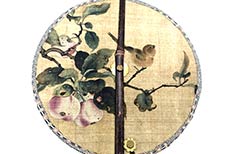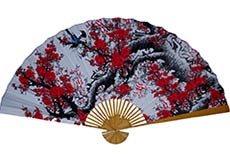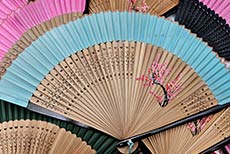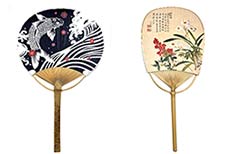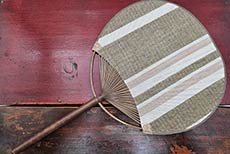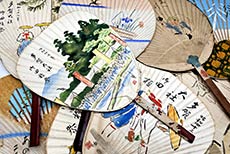Traditional Fans for Sale - Explore Our Wide Range of Fans
Discover the timeless elegance of Chinese and Japanese fans, genuine traditional masterpieces, handcrafted with centuries-old craftsmanship. With us, craftsmanship is at the heart of every fan, every fold, and every detail, creating unique pieces infused with the rich history and culture of Asia. We offer you a wide selection of fans, from the latest creations to ancient treasures. Whether you're looking for a modern fan for a touch of contemporary style or an antique fan for a true immersion in history, our collection provides an unmatched variety. Each of our fans tells a story, carrying the essence of tradition and meticulous craftsmanship. Explore our selection and find the perfect fan for your taste and style.
Asian Fans: China and Japan
A Chinese proverb says: "The fan is like a loyal friend. It brings comfort and coolness when times are hot, and its company is always appreciated."
Fans: An Art Based on Strict Codes and Criteria:
Fans, whether from China or Japan, are more than just accessories. They are a reflection of a long artistic and cultural tradition, where every fold and movement adheres to strict codes and criteria. In these two civilizations, the fan is elevated to the status of art, infused with deep meanings and subtle rules.
Chinese Fans: the art of the fan dates back thousands of years. Each fan is designed to embody beauty, harmony, and subtlety. Each fold is carefully studied to create aesthetic patterns and compositions. The choice of materials, such as silk, paper, bamboo, or ivory, is crucial to create fans that are both lightweight and elegant. The colors, symbols, and motifs used have specific meanings, conveying subtle messages about Chinese culture, history, and philosophy.
Japanese Fans: fans in Japan are equally steeped in tradition and refinement. Origami, the art of folding, is an essential component in the creation of Japanese fans. Fans are often decorated with meticulous paintings or elegant calligraphy. Every gesture of opening or closing a fan can be considered a form of subtle body language, used in traditional Japanese dance, Noh theater, and other performing arts to express emotions and narratives.
In both cultures, fans are not just artistic objects but also tools of communication. They can express politeness, gratitude, love, melancholy, joy, or anger while adhering to precise gestures and movements. These strict codes and criteria surround the art of the fan, making it much more than a mere accessory. They testify to the depth of Chinese and Japanese culture and artistic sensibility. Each fan tells a story, conveys an emotion, and embodies the richness of these millennia-old traditions. As functional works of art, fans celebrate the union of beauty, tradition, and utility.
The Making of Fans:
The production of Chinese and Japanese fans made of bamboo is a meticulous and artisanal process. Here are the general steps in the making of these fans:
1. Bamboo selection: First, quality bamboo is chosen. Bamboo is ideal due to its lightness, flexibility, and durability.
2. Cutting and preparing the bamboo: The bamboo is cut into suitable lengths and then split into thin slats. These slats will serve as the fan's ribs.
3. Soaking and softening: The bamboo slats are soaked in hot water or steam to make them pliable. This allows bending the slats without breaking them.
4. Bending and cutting: Each slat is bent to give it the characteristic curved shape of a fan. Then, the slats are cut according to the desired size and shape of the fan.
5. Gluing and reinforcing: The curved slats are glued together to form the fan's structure. Additional slats can be added for reinforcement.
6. Fabric or paper: Fabric (typically silk) or paper is cut into the shape of the fan and then attached to the bamboo structure using glue.
7. Decoration: The decoration stage is crucial. Patterns, paintings, calligraphy, or other decorative elements can be added to the fabric or paper. These decorations vary depending on the style of the fan and its intended use.
8. Finishing touches: The edges of the fan are often adorned with ribbons, cords, or embroidery. The finishing touches contribute to the fan's aesthetics. 9. Varnishing: To protect the fan and enhance its durability, a layer of varnish can be applied to the bamboo.
10. Assembly: Once all components are assembled and dried, the fan is ready for use or sale. The production of bamboo fans can vary based on style, region, and craftsmanship level. Skilled artisans often make subtle modifications to this basic process to create unique and beautiful fans. Fans made in this way are complete works of art, showcasing mastery of craftsmanship skills and respect for traditions.
Fans - A Long-Neglected Art:
For centuries, fans have been more than just a means to cool off in hot weather. They have played a key role in the culture, art, and history of many civilizations around the world. However, the art of fans is often overlooked and underestimated. By exploring their history, significance, and impact, we can discover the importance of these often ignored objects.
A Millennia-Old History: Fans have a long and rich history, dating back thousands of years. They were used in ancient civilizations in China, Japan, Egypt, Greece, and elsewhere. They evolved from simple palm leaves or papyrus into sophisticated works of art adorned with patterns, paintings, and calligraphy.
Symbols of Culture and Tradition: In many cultures, fans have become symbols of tradition, social status, and cultural significance. In China, for example, each fan reflects Chinese history, philosophy, and aesthetics. They are used in dance, calligraphy, and poetry to express emotions and narratives.
An Artistic Expression: The art of fans is a complete form of artistic expression. Talented artisans create fans of various kinds, from silk to feathers to paper, crafting intricate patterns and sublime works of art. Fans can serve as canvases for creativity and artistic expression.
A Utilitarian and Aesthetic Object: Fans are not merely decorative items; they are also practical. They are used to cool off in hot weather, protect from the sun, or accentuate movements in traditional dances. Their practical utility harmoniously coexists with their aesthetic beauty.
An Art Long Overlooked: Despite their rich history and cultural importance, fans are often underappreciated and neglected. However, it's time to rediscover this fascinating art. Fans are more than mere accessories; they carry culture, history, and emotion. By studying and appreciating them, we can better understand and celebrate the artistic and cultural heritage they represent. Fans deserve recognition as the precious and fascinating art they are.
Chinese and Japanese Fans: Art, Tradition, and Elegance in a Breeze
Discover the elegance and authenticity of Chinese and Japanese fans with us. Each fan is a carefully crafted piece of art, embodying centuries of tradition and culture. Our fans, ranging from the latest creations to ancient treasures, are gems of craftsmanship and design. Explore our exceptional collection to find the fan that reflects your style and personality. We are committed to offering you quality, authenticity, and the charm of Asia. Each of our fans is meticulously handcrafted, combining the beauty of bamboo and fabric or paper with artistic patterns that tell unique stories. As enthusiasts of the art of fans, we are proud to share this tradition with the world.
Discover the essence of Chinese and Japanese culture through these functional works of art. Add a touch of Asia to your life, whether it's for a special occasion, unique decoration, or a memorable gift. Don't miss this opportunity to own a piece of Asia's history and beauty. Order now and enjoy fast delivery and a wide selection of available styles. Let Chinese and Japanese fans enrich your life with grace, elegance, and tradition.










